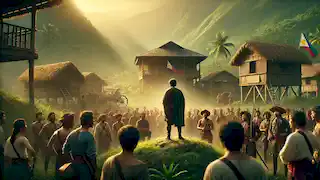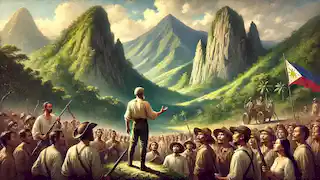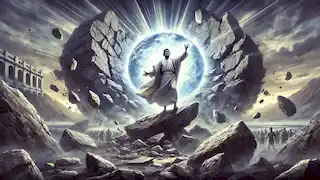The Legend of Bernardo Carpio
Reading time: 9 min

About this story: The Legend of Bernardo Carpio is a Legend from Philippines set in the 18th Century This Dramatic tale explores themes of Perseverance and is suitable for All Ages. It offers Cultural insights. The legend of a mighty hero trapped between mountains, awaiting the moment to rise and free his people.
(Philippines)
In the mountainous heart of the Philippines, where the peaks of Montalban rise high and stand tall against the sky, there exists an ancient tale that has been passed down through generations. It is the story of a man, neither a god nor a mere mortal, whose strength was unmatched and whose fate was as heavy as the boulders that surrounded him. His name was Bernardo Carpio, and his legend lives on in the very stones that seem to breathe his legacy.
{{{_intro}}}
The Beginning of Bernardo Carpio
Long ago, in a time when the land was still ruled by foreign invaders, the people of the Philippines lived in subjugation. Yet, in their hearts, they held a strong belief that one day a savior would come to free them from their shackles. That hope was embodied in the form of Bernardo Carpio, a man blessed by the heavens with immense power, destined to become a symbol of resistance against oppression.
Bernardo Carpio was born in the small town of Montalban, raised by humble parents who worked hard to survive the harshness of their reality. His father, Juan, was a blacksmith, and his mother, Maria, a gentle soul, known for her wisdom and deep connection to the spiritual world. As a child, Bernardo showed signs of his incredible strength. He could lift heavy objects with ease, and by the time he was a young man, there was not a single person in the town who could match him in a contest of strength.
The people of Montalban knew that Bernardo was no ordinary man. Legends spoke of his lineage being tied to ancient giants who once roamed the land. His stature, towering over other men, and his physical prowess only reinforced these beliefs. Yet, despite his power, Bernardo was known for his humility and kindness. He used his strength not for his own gain, but to help his people, lifting burdens both literal and metaphorical.
The Oppression of the Land
During this time, the Philippines was under the rule of foreign colonizers, and the people suffered greatly. The Spaniards, who had arrived centuries earlier, imposed harsh taxes, forced labor, and brutal punishments on the native Filipinos. The people of Montalban were no exception. Their crops were seized, and their young men were conscripted into the colonial army, leaving families broken and communities in despair.
Bernardo, witnessing the suffering of his people, felt a deep anger stir within him. He could not stand by and watch as the colonizers continued to oppress those he loved. His strength, he realized, was a gift that could be used to fight back. And so, he began to gather like-minded men from his town and surrounding villages, men who were tired of living under the cruel yoke of foreign rule.
At first, they waged small, strategic attacks on the Spanish garrisons. Bernardo and his men became known as a band of rebels, moving swiftly and striking with precision. Their success in these skirmishes quickly spread, and soon, Bernardo Carpio’s name was spoken with both fear and reverence. To the Spaniards, he was a dangerous rebel leader; to the Filipinos, he was a beacon of hope, a symbol of the strength they could muster against their oppressors.
The Mountains of Montalban
As the rebellion grew, Bernardo and his men found themselves pushed deeper into the mountains, where they sought refuge from the pursuing Spanish forces. The Sierra Madre range, with its dense forests and towering peaks, became their sanctuary. It was here, amidst the rugged terrain, that Bernardo’s legend truly took shape.
One of the most famous tales associated with Bernardo Carpio involves two massive boulders in the mountains of Montalban, known as the Pamitinan and the Susong Dalaga. According to legend, these boulders were once enchanted by two warring giants, who fought for control over the land. In their struggle, they caused a great earthquake, which trapped Bernardo between the two stones. With his immense strength, Bernardo was able to hold the rocks apart, preventing them from crushing him, but he could not free himself completely. Bound by the curse of the giants, Bernardo remains trapped between the boulders to this day, his strength keeping them from collapsing.
The Curse of Bernardo Carpio
The story of Bernardo Carpio’s entrapment is as much a story of heroism as it is of tragedy. Despite his unmatched strength, even Bernardo could not escape the curse that held him captive. Legend says that his imprisonment was not just physical but also symbolic. Bernardo was said to represent the Filipino people themselves, trapped between the forces of colonialism and their desire for freedom. His endless struggle mirrored the fight of the people, forever caught between oppression and the hope for liberation.

According to some versions of the legend, Bernardo’s imprisonment was part of a divine plan. The gods, seeing the suffering of the Filipinos, decreed that one day Bernardo would break free from the boulders. When that time came, he would lead his people to victory against their oppressors and bring peace to the land. However, until that day arrived, he would remain trapped, his strength the only thing preventing the collapse of the mountains.
This part of the legend has given rise to a long-standing belief that Bernardo Carpio is still alive, waiting for the right moment to free himself and save the Philippines. Some even say that during times of great hardship, the earth shakes as Bernardo struggles to break free from his rocky prison. Earthquakes in the region are often attributed to his efforts to escape, a reminder to the people that their hero is still with them, fighting for their freedom.
The Spirit of Resistance
Though Bernardo Carpio remains trapped between the boulders, his spirit lives on in the hearts of the Filipino people. Throughout the centuries, his story has been told and retold, evolving with the times but always carrying the same message of hope and resistance. During the Philippine Revolution in the late 19th century, when the country fought for independence from Spain, many revolutionaries looked to Bernardo Carpio as a symbol of their struggle.

The revolutionary leader Andres Bonifacio, who himself hailed from humble beginnings, often invoked the legend of Bernardo Carpio in his speeches. He urged his fellow Filipinos to embody the strength and courage of their legendary hero, to fight for their freedom even in the face of overwhelming odds. Bonifacio and the Katipunan, the revolutionary organization he led, adopted the spirit of Bernardo Carpio as they waged their war against the Spanish colonizers.
Even after the revolution, as the Philippines continued to face foreign domination and internal strife, the legend of Bernardo Carpio endured. During World War II, when the country was occupied by Japanese forces, Filipino guerrillas once again drew inspiration from the tale of the trapped hero. In every struggle for independence, in every fight against tyranny, the people have looked to Bernardo Carpio as a reminder of their strength, their resilience, and their enduring hope.
Bernardo Carpio’s Legacy
Today, the story of Bernardo Carpio remains one of the most enduring legends in Philippine folklore. His tale is told in schools, passed down through families, and celebrated in festivals. The mountains of Montalban, where he is said to remain trapped, are still visited by those who wish to pay homage to the legendary hero. The great boulders, Pamitinan and Susong Dalaga, stand as silent witnesses to the centuries-old legend, their imposing presence a reminder of Bernardo’s eternal struggle.
In many ways, Bernardo Carpio’s legacy is not just about his legendary strength or his imprisonment between two mountains. It is about the power of belief, the strength of the human spirit, and the enduring hope for freedom. His story has transcended time and circumstance, becoming a symbol of the Filipino people’s ability to endure, to resist, and to dream of a better future.

Though Bernardo may still be trapped in the mountains of Montalban, his presence is felt in every Filipino who fights for justice and equality. His legend has become a part of the national consciousness, a reminder that even in the face of seemingly insurmountable odds, there is always hope. As long as the story of Bernardo Carpio is told, his spirit will continue to inspire future generations to stand strong, to resist oppression, and to strive for the freedom that he represents.
The Return of the Hero
Many believe that the legend of Bernardo Carpio is not yet finished. According to ancient prophecies, there will come a day when the hero will finally break free from his rocky prison. On that day, the earth will tremble, the mountains will shake, and Bernardo Carpio will rise once again. His return, it is said, will mark the beginning of a new era for the Philippines, a time of peace, prosperity, and freedom.

Some say that Bernardo will appear in the nation’s darkest hour, when the people are once again facing great peril. In this time of need, he will emerge from the mountains, his strength restored, and lead his people to victory against their enemies. The prophecy is a source of hope for many, a belief that no matter how difficult the struggle may be, there is always a hero waiting to rise.
Until that day comes, the story of Bernardo Carpio will continue to be told. His legend will live on in the hearts of the Filipino people, a reminder that they are never truly alone in their fight for freedom. And as long as the mountains of Montalban stand, so too will the memory of the great Bernardo Carpio, the hero who, even in his imprisonment, remains a symbol of strength, resistance, and the unbreakable spirit of the Filipino people.


















